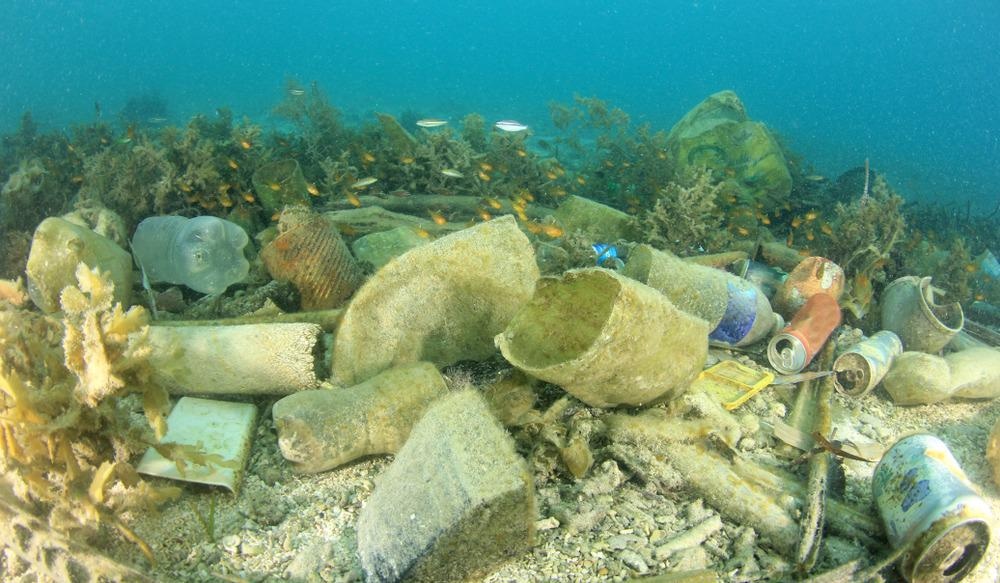An imbalance in the amount of plastic floating on the surface of the ocean and the volume leaking into the ocean by rivers led scientists to believe an unidentified sink was removing the river-sourced plastics quickly from the ocean surface.

Image Credit: Rich Carey/Shutterstock.com
However, several miscalculations mean the mass fluxes or flows have been overestimated by two to three orders of magnitude. This increased the average residence time of microplastics at the ocean surface from a matter of days to several years and implies they exist for longer periods and take more time to degrade than previously thought, negating the need for a missing sink.
Plastic Problem
Plastic is an ever-increasing threat to the environment, one that persists for thousands of years. They are a danger to every natural ecosystem, but particularly marine and freshwater environments. Poor land-based waste management means several million metric tons of plastics make their way in to rivers, the main source of plastic pollution, every year.
Current assessments suggest the floating mass of microplastics on the ocean surface ranges from tens to hundreds of metric tons – only a small fraction of the amount makes its way to the ocean from rivers. To account for this imbalance, scientists, therefore, believed there must be a missing sink of plastic somewhere in the ocean.
However, a new paper from the Centre of Education and Research on Mediterranean Environments (CEFREM) suggests current river flux figures were overestimated, and that all plastic is accounted for.
The Missing Sink
The study, led by Dr Lisa Weiss of CEFREM, identified several methodological mistakes which led to inaccurate estimates of the fluxes, and therefore the overall mass of microplastics discharged by the rivers into the sea on a global level.
The in-situ data that we now have for microplastics in rivers, compared to early empirical modelling studies, allowed us to assemble a robust database which we were then able to analyze to obtain a more reliable estimate for the quantity of microplastics being discharged from rivers into the sea."
Dr Lisa Weiss, CEFREM
This process exposed several noteworthy methodological errors in previous flow estimates, including:
- A systematic overestimation of the average microplastic particle weight in river samples
- The integration of incompatible data obtained through different sampling techniques
- Assessments based on the relationship between microplastic fluxes and the mismanaged plastic waste (MPW) index
“When we then corrected these mistakes, we found that the global river flux estimates are two to three orders of magnitude less than previously thought,” says Weiss. “Further, we found that the average residence time for microplastics at the surface of the oceans may actually be a few years as opposed to only several days, as previously estimated.”
Persistent Plastics
Although the scientists have corrected river flux estimates and confirmed there is no missing sink of plastics, it does not mean plastic is any less of a problem. Scientists are only just beginning to understand how plastic flows into the ocean and what effects it has. Further research is needed into plastic size classes, oceanic compartments, and land-to-sea transfer processes to properly evaluate the state of ocean plastic pollution.
The best-available science will be needed to win the battle against plastic pollution, and to protect and preserve the planet’s oceans and its inhabitants – and it starts with the source of the pollution.
“The only way we are going to have a chance at winning the fight against microplastic pollution will be to target the sources where microplastic waste is generated,” says Dr. Wolfgang Ludwig, Director of the CEFREM laboratory and co-author of the study.
We need to take action at the human level. We need to change our consumption habits, better manage our waste and we need to do this at a global scale.”
Dr. Wolfgang Ludwig, Director of the CEFREM laboratory
The study shows that marine microplastic pollution originates from both developing countries with little to no waste management, and from countries with well-established systems, says Ludwig, adding “If we were to stop the discharge of microplastics from rivers to the sea today, the amount of floating particles and their harmful effects on marine ecosystems would persist for at least another several years.”
References and Further Reading
University of Barcelona (2021) The missing ocean plastic sink: Gone with the rivers. [Online] AlphaGalileo - https://www.alphagalileo.org/en-gb/Item-Display/ItemId/210177. Accessed 8 July 2021.
Weiss, L et al. (2021) The missing ocean plastic sink: Gone with the rivers, Science - https://science.sciencemag.org/content/373/6550/107. Accessed 8 July 2021.
Disclaimer: The views expressed here are those of the author expressed in their private capacity and do not necessarily represent the views of AZoM.com Limited T/A AZoNetwork the owner and operator of this website. This disclaimer forms part of the Terms and conditions of use of this website.